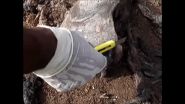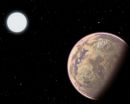(Press-News.org) From AGU's blogs: Oso disaster had its roots in earlier landslides
A research team tasked with being some of the first scientists and engineers to evaluate extreme events has issued its findings on disastrous Oso, Washington, landslide. The report studies the conditions and causes related to the March 22 mudslide that killed 43 people and destroyed the Steelhead Haven neighborhood in Oso, Washington. The team from the Geotechnical Extreme Events Reconnaissance (GEER) Association, funded by the National Science Foundation, determined that intense rainfall in the three weeks before the slide likely was a major issue, but factors such as altered groundwater migration, weakened soil consistency because of previous landslides and changes in hillside stresses played key roles.
From this week's Eos: Reducing Rockfall Risk in Yosemite National Park
The glacially sculpted granite walls of Yosemite Valley attract 4 million visitors a year, but rockfalls from these cliffs pose substantial hazards. Responding to new studies, the National Park Service recently took actions to reduce the human risk posed by rockfalls in Yosemite National Park.
From AGU's journals: A new earthquake model may explain discrepancies in San Andreas fault slip
Investigating the earthquake hazards of the San Andreas Fault System requires an accurate understanding of accumulating stresses and the history of past earthquakes. Faults tend to go through an "earthquake cycle"—locking and accumulating stress, rupturing in an earthquake, and locking again in a well-accepted process known as "elastic rebound." One of the key factors in preparing for California's next "Big One" is estimating the fault slip rate, the speed at which one side of the San Andreas Fault is moving past the other.
Broadly speaking, there are two ways geoscientists study fault slip. Geologists formulate estimates by studying geologic features at key locations to study slip rates through time. Geodesists, scientists who measure the size and shape of the planet, use technologies like GPS and satellite radar interferometry to estimate the slip rate, estimates which often differ from the geologists' estimations.
In a recent study by Tong et al., the authors develop a new three-dimensional viscoelastic earthquake cycle model that represents 41 major fault segments of the San Andreas Fault System. While previous research has suggested that there are discrepancies between the fault slip rates along the San Andreas as measured by geologic and geodetic means, the authors find that there are no significant differences between the two measures if the thickness of the tectonic plate and viscoelasticity are taken into account. The authors find that the geodetic slip rate depends on the plate thickness over the San Andreas, a variable lacking in previous research.
The team notes that of the 41 studied faults within the San Andreas Fault system, a small number do in fact have disagreements between the geologic and geodetic slip rates. These differences could be attributed to inadequate data coverage or to incomplete knowledge of the fault structures or the chronological sequence of past events.
Click here for the online version of This Week From AGU.
Click here to register for access to AGU journal papers and Eos, the newspaper of the Earth and space sciences.
INFORMATION:
The American Geophysical Union is dedicated to advancing the Earth and space sciences for the benefit of humanity through its scholarly publications, conferences, and outreach programs. AGU is a not-for-profit, professional, scientific organization representing more than 62,000 members in 144 countries. Join our conversation on Facebook, Twitter, YouTube, and other social media channels.
This week from AGU: Oso report, rockfall in Yosemite Park, and a new ear
2014-07-23
ELSE PRESS RELEASES FROM THIS DATE:
Protein evolution follows a modular principle
2014-07-23
This news release is available in German.
Proteins impart shape and stability to cells, drive metabolic processes and transmit signals. To perform these manifold tasks, they fold into complex three-dimensional shapes. Scientists at the Max Planck Institute for Developmental Biology in Tübingen have now discovered that proteins can be constructed of similar amino acid chains even when their three-dimensional shapes differ significantly. This suggests that the proteins that exist today arose from common precursors. Presumably, in the course of evolution they were ...
Dead body feeding larvae useful in forensic investigations
2014-07-23
VIDEO:
This image depicts Chrysomya megacephala larvae on decomposing fish.
Click here for more information.
Non-biting blow fly Chrysomya megacephala is commonly found in dead bodies and is used in forensic investigations to determine the time of death, referred to as the post mortem interval. A report of synanthropic derived form of C. megacephala from Tamil Nadu is provided for the first time based on morphological features and molecular characterization through generation ...
Study provides new perspectives on the current Clostridium difficile epidemic
2014-07-23
PASADENA, Calif., July 23, 2014 — More than 80 percent of hospitalized patients who tested positive for Clostridium difficile were tested outside the hospital or within the first 72 hours of hospitalization, suggesting that settings outside of the hospital may play key roles in the identification, onset and possible transmission of the disease, according to a new Kaiser Permanente study published today in the journal Mayo Clinic Proceedings.
The study provides new insight into the contagious and potentially deadly infection also known as C. diff, a bacterium most often ...
Nano-sized chip "sniffs out" explosives far better than trained dogs
2014-07-23
Security forces worldwide rely on sophisticated equipment, trained personnel, and detection dogs to safeguard airports and other public areas against terrorist attacks. A revolutionary new electronic chip with nano-sized chemical sensors is about to make their job much easier.
The groundbreaking nanotechnology-inspired sensor, devised by Prof. Fernando Patolsky of Tel Aviv University 's School of Chemistry and Center for Nanoscience and Nanotechnology, and developed by the Herzliya company Tracense, picks up the scent of explosives molecules better than a detection dog's ...
Statin use decreases the risk of Barrett's esophagus
2014-07-23
Bethesda, MD (July 23, 2014) — Statins, a class of drugs commonly used to lower cholesterol levels, significantly reduce a patient's risk of developing Barrett's esophagus, according to a new study in Gastroenterology1, the official journal of the American Gastroenterological Association. Obese patients experienced the greatest level of risk reduction with statin use.
"Patients who received statins had a 43 percent reduction in the odds of having Barrett's esophagus compared to non-users," said study author Hashem B. El-Serag, MD, MPH, from the Houston VA Medical Center ...
Rosemary and oregano contain diabetes-fighting compounds
2014-07-23
The popular culinary herbs oregano and rosemary are packed with healthful compounds, and now lab tests show they could work in much the same way as prescription anti-diabetic medication, scientists report. In their new study published in ACS' Journal of Agricultural and Food Chemistry, they found that how the herbs are grown makes a difference, and they also identified which compounds contribute the most to this promising trait.
Elvira Gonzalez de Mejia and colleagues point out that in 2012, type-2 diabetes affected more than 8 percent of Americans and cost the country ...
The geography of the global electronic waste ('e-waste') burden
2014-07-23
As local and national governments struggle to deal with ever-growing piles of electronic waste (or "e-waste"), scientists are now refining the picture of just how much there is and where it really ends up. Published in the ACS journal Environmental Science & Technology, their study found that nearly a quarter of e-waste that developed countries discard floods into just seven developing countries — with major potential health risks for the people who live there.
Knut Breivik and colleagues note that the export from developed to developing regions of e-waste — everything ...
Researchers unlock the protein puzzle
2014-07-23
By using brightly hued dyes, George Mason University researchers discovered an innovative way to reveal where proteins touch each other, possibly leading to new treatments for cancer, arthritis, heart disease and even lung disease.
George Mason researchers unraveled the mystery of deciphering the contact points where proteins touch each other. "One protein interlocks with another protein like adjacent pieces in a jigsaw puzzle, and this sends a signal down the line to the next protein," says Lance Liotta, co-director of the Mason-based Center for Applied Proteomics and ...
A new approach in the search for extraterrestrial intelligence: targeting alien polluters
2014-07-23
Humanity is on the threshold of being able to detect signs of alien life on other worlds. By studying exoplanet atmospheres, we can look for gases like oxygen and methane that only coexist if replenished by life. But those gases come from simple life forms like microbes. What about advanced civilizations? Would they leave any detectable signs?
They might, if they spew industrial pollution into the atmosphere. New research by theorists at the Harvard-Smithsonian Center for Astrophysics (CfA) shows that we could spot the fingerprints of certain pollutants under ideal conditions. ...
An increase in temperature by 2050 may be advantageous to the growth of forage plants
2014-07-23
A 2°C increase in temperature around the world by 2050, according to one of the scenarios predicted by the Intergovernmental Panel on Climate Change (IPCC), may be advantageous to the physiology and the biochemical and biophysical processes involved in the growth of forage plants such as Stylosanthes capitata Vogel, a legume utilized for livestock grazing in tropical countries such as Brazil.
The conclusion is from a study carried out by researchers in the Department of Biology at the Ribeirão Preto Faculty of Philosophy, Sciences and Languages and Literature at the University ...


